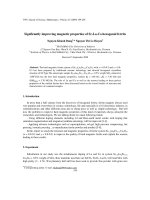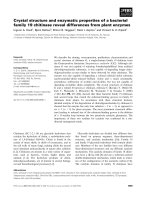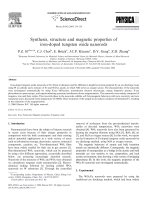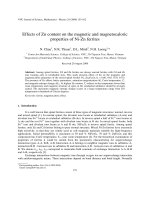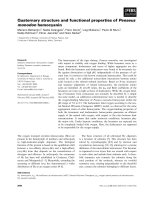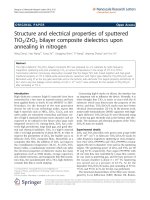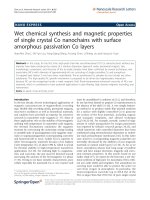Structure and magnetic properties of ni nio, co coo composite films
Bạn đang xem bản rút gọn của tài liệu. Xem và tải ngay bản đầy đủ của tài liệu tại đây (9.78 MB, 180 trang )
STRUCTURE AND MAGNETIC PROPERTIES OF Ni/NiO,
Co/CoO COMPOSITE FILMS
YI JIABAO
(B. ENG. TIANJIN UNIV. CHINA)
A THESIS SUBMITTED
FOR THE DEGREE OF DOCTOR OF
PHILOSOPHY
DEPARTMENT OF MATERIALS SCIENCE
NATIONAL UNIVERSITY OF SINGAPORE
2007
i
ACKNOWLEDGEMENTS
First and foremost I will offer my most sincere gratitude to my supervisor, Dr Ding Jun,
who has supported me throughout my thesis with his immense patience and knowledge
whilst allowing me the space to work in my own way. Without his encourage and
effort, this thesis would not have been completed and written. I really appreciate his
efforts in imparting the knowledge of materials science and magnetic materials. The
novel and creative ideas given by Dr. Ding were indispensable to my research during
the period of my PhD candidature in the Department of Materials Science and
Engineering, National University of Singapore.
I would also like to acknowledge Prof. Feng Yuanping for the first principle
calculations of NiO. I am truly indebted to the members of magnetic materials group in
the Department of Materials Science and Engineering, who have been extremely
helpful with their kind assistance and friendships. The active discussions throughout
the study were most beneficial and resourceful. Special thanks are given to the lab
officers of the Department of Materials Science and Engineering due to their technical
support. I would also like to express my utmost gratitude to the financial support
provided by the National University of Singapore.
Last but not least, I am especially grateful to my wife, Tong Ying, and son for their
encouragement, utmost care and support throughout the entire execution of the project.
ii
Publications during PhD study
1. J.B. Yi, Y.Z. Zhou, J. Ding, G.M. Chow, Z.L. Dong, T. White, X.Y. Gao, A.T.S
Wee, and X.J. Yu, “An investigation of structure, magnetic properties and
magnetoresistance of Ni films prepared by sputtering” J. Magn. Magn. Mater. 284,
303 (2004).
2. Y.C. Wang, J. Ding, J.B. Yi, B.H. Liu, T. Yu, Z.X. Shen, “High Coercivity Co-
ferrite thin films on (100)-SiO
2
substrate” Appl. Phys. Lett. 84, 2596 (2004).
3. H. Pan, B.H. Liu, J.B. Yi, C. Poh, S. Lim, J. Ding, Y. P. Feng, and J.Y. Lin,
“Magnetic properties of single crystalline Ni and Co nanowires”, J. Phys. Chem. B
109, 3098 (2005).
4. J.B. Yi, J. Ding, Z.L. Zhao, and B.H. Liu, “High coercivity and exchange
coupling of Ni/NiO nanocomposite film” J. Appl. Phys. 97, 10K 306 (2005).
5. J.B. Yi and J. Ding, “Exchange coupling in ferromagnetic/antiferromagnetic
nanohybrid films” Solid state phenomenon 11, 175 (2006).
6. J.B. Yi and J. Ding, “Exchange coupling in amorphous CoO/crystalline Co
bilayer”. J. Magn. Magn. Mater. 303, 160 (2006).
7. Z. L. Zhao, J.S. Chen, J. Ding , J. B. Yi, B. H. Liu, and J.P. Wang, “Formation
and microstructure of high coercivity FePt thin films deposited at 400
o
C” Appl. Phys.
Lett. 88, 052503 (2006).
8. H. Pan, J.B. Yi, B.H. Liu, S. Thongmee, J. Ding, Y.P. Feng, J.Y. Lin,
“
Magnetic
properties of highly-ordered Ni, Co and their alloy nanowires in AAO templates”.
Solid State Phenomenon 111, 123 (2006).
9. S.L. Tey, M.V. Reddy, G.V. Subba Rao, B.V.R. Chowdari, J.B. Yi, J. Ding,
and
J.J. Vittal, “Synthesis, structure and magnetic properties of
[Li(H
2
O)M(N
2
H
3
CO
2
)
3
]·0.5H
2
O (M = Co,Ni) as Single Precursors to LiMO
2
Battery
materials” Chem. Mater. 18, 1587 (2006).
10. J.B. Yi, X.P. Li, J. Ding, and H.L. Seet, “Study of the grain size, particle size and
roughness of substrate in relation to the magnetic properties of electroplated
permalloy”, J. Alloy and Comp. 428, 230 (2007).
11. X.P. Li, J.B. Yi, J. Ding, C.M. Koh, and H.L. Seet, J.H. Yin, S. Thongmee,
“Effect of sputtered seed layer on electrodeposited Ni
80
Fe
20
/Cu composite wires”
IEEE, Trans. Magn. 43, 2983 (2007).
12. J.B. Yi, X.P. Li, J. Ding, J.H. Yin, S. Thongmee, H.L. Seet, “Microstructure
evolution of Ni
80
Fe
20
/Cu composite wires deposited by electroplating under an applied
field” IEEE, Trans. Magn. 43, 2980 (2007).
iii
13. J.B. Yi, Y.P. Feng, J. Ding, G.M. Chow. B.H. Liu, and J.H. Yin. “Evolution of
structural and magnetism of NiO from amorphous, clusters to nanocrystalline” Phys.
Rev. B 76, 224402 (2007).
14. H. Pan, J.B. Yi, R.Q. Wu, S. Lei, J.H. Yang, J.Y. Lin, Y.P. Feng, J. Ding, L.H.
Van, and J.H. Yin “Room temperature ferromagnetism in carbon-doped ZnO” Phys.
Rev. Lett. 99, 127201 (2007).
iv
Table of Contents
Acknowlegements i
Publications during PhD study ii
Table of contents………… iv
Summary…………….…. x
List of tables ……… xii
List of figures and illustration…… xiii
Chapter 1 Introduction 1
1.1 Brief review of magnetic properteis of materails 2
1.1.1 Origin of magetism 2
1.1.2 Type of magnetism 3
1.1.2.1 Diamagnetism 3
1.1.2.2 Paramagnetism 3
1.1.2.3 Ferromagnetism 5
1.1.2.4 Antiferromagnetism 7
1.1.2.5 Ferrimagnetism 9
1.2 Hysteresis loops 9
1.3 Exchange coupling between ferromagnet and antiferromagnet 11
1.3.1 Theories 11
1.3.2 High coercivity in exchange coupling system 15
1.3.3 △ M curves 16
1.3.4 Antiferromagnet in exchange coupling 17
1.3.5 NiO and CoO in the exchange coupling 17
1.4 The magnetization of NiO particles 19
1.5 Motivations 20
v
1.6 Summary………. 22
References… 23
Chapter 2 Experimental Procedures 28
2.1 Film deposition: Sputtering 29
2.2 X-ray diffraction (XRD) 31
2.3 Scanning electron microscopy (SEM) 33
2.4 Energy disperse x-ray spectrometer (EDS) 34
2.5 Atomic force microscopy (AFM) 34
2.6 Raman spectroscopy 35
2.7 X-ray photonelectron spectroscopy (XPS) 36
2.8 Tansmission electron microscopy (TEM) 37
2.9 Vibrating sample magnetometer (VSM) 39
2.10 Superconducting quantum interference device (SQUID) 40
2.10 Extending absorption X-ray fine structure (EAXFS) 41
2.10 X-ray magnetic circular dichroism (XMCD) 45
2.11 Summary 48
References… 49
Chapter 3 An investigation of structure, and magnetic properties of Ni film
prepared by sputtering ………… 50
3.1 Introduction 51
3.2 Experimental procedure 51
3.3 Characterization and microstructure analysis 52
3.3.1 Calibration for the thickness and deposition rate…………… 52
3.3.2 XRD analysis. 53
3.3.3 TEM analysis. 54
vi
3.3.4 Coordination number examined by EXAFS 58
3.3.5. SEM analysis of the annealed Ni films…………… 59
3.4 Magnetic properties 62
3.5 Resistivity 63
3.6 Discussion 64
3.6.1 The effect of substrate and sputtering power on the saturation magnetization
of Ni films. 65
3.6.2 XMCD analysis. 68
3.7 Summary 68
References… 69
Chapter 4 Magnetism evoution of NiO from amorphous, cluster to
nanocrystalline structures…………………. 71
4.1 Introduction 72
4.2 Experimental procedure 72
4.3 Synthesis and analysis of amorphous, cluster, and nanocrystalline
specimens ………………………………… 73
4.3.1 Synthesis of fully amorphous NiO by sputtering 73
4.3.2 Synthesis of NiO in the cluster and nanocrystalline structure (Co-
precipitation and subsequent annealing) 75
4.3.2.1 Thermal gravitation analysis (TGA) 75
4.3.2.2 XRD analysis 77
4.3.2.3 Structure analysis by TEM 78
4.4 Maxmium magnetization of NiO with different structures (Amorphous, cluster
and nanocrystalline) 81
4.5 Antiferromagnetism in fully amorphous NiO 83
vii
4.6 Ferromagnetism in NiO clusters 85
4.6.1 Estimation of the Curie temperature of the ferromagnetism 85
4.6.2 Spin glass behavior 87
4.7 First principle calculation 90
4.8 Core/shell interactions in nanocrystals 92
4.8.1 The description of surface spins and antiferromagnetic core. 93
4.8.2 Annealing temperature dependence of exchange bias and coercivity of NiO
powders 93
4.8.3 Temperature dependence of exchange bias and coercivity of NiO powders
annealed at different temperatures. 96
4.9 Superparamgnetism in NiO powders 98
4.9.1 Superparamagnetism according to Néel model 98
4.9.2 Anisotropy of NiO powders 99
4.10 Summary 102
References… 104
Chapter 5 Magnetic properties of Ni/NiO nanocomposites prepared by reactive
sputtering………. 106
5.1 Introduction 107
5.2 Experimental procedure 107
5.3 Structure and characterization 100
5.3.1 Cross-section TEM analysis 108
5.3.2 XRD analysis 101
5.3.3 In-plane TEM analysis 109
5.4 Magnetization of Ni/NiO composite films. 113
viii
5.4.1 Saturation magnetization of Ni/NiO composites after annealing at different
temperatures…………… 113
5.4.2 In-plane and out-of-plane hysteresis loops of Ni/NiO composites annealed at
200
o
C. 115
5.4.3 Temperature dependence of magnetization of Ni/NiO composites annealed at
200
o
C. 116
5.4.4 Cure Temperature of Ni/NiO composites annealed at 200
o
C. 117
5.5 Exchange bias phenomenon in Ni/NiO composites 119
5.5.1 Hysteresis loops taken at different temperatures 119
5.5.2 Temperature dependence of exchange bias and coercivity of the Ni/NiO
annealed at 350
o
C. 122
5.5.3 ZFC and FC curves of Ni/NiO composites anealed at 350
o
C 123
5.6 Composition effect 124
5.7 Summary 125
References… 127
Chapter 6 Coercivity and exchange bias of Ni/NiO nanocomposite films prepared
by oxidation during magnetic annealing 129
6.1 Introduction 130
6.2 Experimental procedure 130
6.3 Effect of composition on the magnetic properties of Ni/NiO composites 131
6.4 Effect of magnetic field on the magnetic properteis of Ni/NiO composites. . 132
6.5 Phase and microstructure analysis 133
6.5.1 XRD analysis 133
6.5.2 TEM analysis 133
6.6 Magnetic properties of Ni/NiO composites prepared by magnetic annealing 136
ix
6.6.1 Room temperature hysteresis loops 1136
6.6.2 Temperature dependence of coercivity and exchange bias 137
6.6.3 Blocking temperature 138
6.6.4
M
∆
curve analysis 139
6.7 Summary… 140
References… 141
Chapter 7 Coercvity and exchange bias of Co/CoO nanocomposite films prepared
by oxidation during magnetic annealing……… 143
7.1 Introduction 144
7.2 Experimental procedure 144
7.3 The results of Co and CoO prepared by sputtering 144
7.4 Characterization and microstructure analysis 146
7.4.1 XRD analysis 146
7.4.2 Raman spectroscopy analysis 147
7.4.3 TEM analysis 148
7.5 Composition study and its effect on the magnetic properties 150
7.6 Temperature dependence of magnetic properties 152
7.7 Comparison of the hysteresis loops of Co/CoO composite films by magnetic
annealing under an oxygen partial pressure and by sputtering with an oxygen
partial pressure… 154
7.8 Summary…… 155
References… 156
Chapter 8 Conclusions and future work 157
8.1 Conclusions 150
8.2 Future works… 160
x
Summary
This project focused on understanding of the magnetic properties of Ni and NiO in the
amorphous or disordered, cluster, nanocrystalline and well crystalline states and the
understanding of the exchange coupling and magnetic behaviors of
ferromagnetic/antiferromagnetic Ni/NiO nanocomposites. In this study, nanostructured
samples were fabricated by co-precipitation and magnetron sputtering. It was found
that NiO exhibited antiferromagnetism in a fully amorphous state with a very low Néel
temperature. Ferromagnetism was observed in NiO clusters. NiO/Ni composite
prepared by sputtering after annealing possessed high values of saturation
magnetization at room temperature (up to 91 emu/g, which is more than two times
larger than that of bulk Ni) due to a strong exchange coupling between Ni crystallites
and NiO clusters. It has been found that NiO with a grain size of 2-4 nm is ideal for
achieving a high coercivity in a Ni/NiO exchange coupling system. A coercivity of 2.4
kOe at room temperature has been achieved in a Ni/NiO composite prepared by
magnetic annealing. Similarly, high coercivity has also been obtained in a Co/CoO
nanocomposite prepared by magnetic annealing. Hence, the method of magnetic
annealing is suitable to achieve high coercivity materials, which may be promising for
the applications of hard magnets. Based on the investigation of this work, the
contribution of the project is summarized below:
1) In this project, a whole picture of the structure and magnetic properties of NiO in
the amorphous, cluster, nanocrystalline, and well crystalline state was well
described. The study showed that amorphous NiO was antiferromagnetic.
Clustered NiO was ferromagnetic with a maximum magnetization of 105 emu/g at
xi
2 K. Nanocrystalline NiO was composed of surface spins or antiferromagnetic
core. The magnetization of the nanocrystalline NiO was contributed from the
surface spins. However, the magnetization was small. Strong exchange coupling
with an exchange bias was observed in this nanocrystalline NiO. First principle
calculation is in good agreement with the experimental results.
2) The composite of Ni/NiO prepared by sputtering annealed at 200
o
C in an argon
atmosphere showed a saturation magnetization of 91 emu/g at room temperature.
In addition, in this study, a high coercivity was achieved at low temperatures (5-
40 K) when the annealing was carried out at 350
o
C.
3) Ni/NiO composite prepared by magnetic annealing showed a coercivity of 2.4 kOe
at room temperature. This value is significant since Ni is one of the soft magnetic
materials and has a low coercivity. The study of the mechanisms indicated that the
high coercivity of the composite was due to the exchange coupling between Ni
and NiO. The small grain size of NiO was attributed to the high coercivity.
Similarly, high coercivity was achieved in a Co/CoO composite prepared by
magnetic annealing. The coercivity of the composite is evidently higher than that
prepared by sputtering under an oxygen partial pressure (reactive sputtering). The
remanence was also enhanced.
xii
List of Tables
Table 3.1. The dependence of saturation magnetization M
s
of Ni films with a thickness
of 100 nm on the substrate and sputtering power.
Table 4.1. The calculated anisotropy energy constant of NiO powders annealed at
different temperatures.
Table 5.1. Composition effect of Ni and NiO on the coercivity and exchange bias. The
exchange bias and coercivity were measured from the composite after annealing at 350
o
C for 30 min.
Table 6.1. The magnetization, composition, coercivity and exchange bias of Ni/NiO
nanocomposite performed magnetic annealing at 380
o
C under an oxygen partial
pressure of 0 (N0), 0.0005 (N0a), 0.001 (N0b), 0.005 (N0c) and 0.01 torr (N0d)
respectively. The composition was obtained by the calculation of the magnetization of
the films.
xiii
List of Figures and Illustrations
Fig. 1.1. A graphic illustration of 1/χ versus T for a paramagnet.
Fig. 1.2. a) The magnetization dependence on the temperature for a ferromagnetic
material below the Curie temperature T
C
; b) the susceptibility as a function of
temperature of a ferromagnetic material above T
C.
Fig. 1.3. Configuration of spin array in an antiferromagnet.
Fig. 1.4. The susceptibility as a function of temperature (T
N
is the Néel temperature).
AF: Antiferromagnetism; P: paramagnetism.
Fig. 1.5. Typical hysteresis loop of a magnetic material.
Fig. 1.6. Curve (1) shows the resulting loop after cooling antiferromagnet/ferromagnet
above the Néel temperature of the antiferromagnet under a magnetic field. Curve (2)
shows the loop when cooled in zero field.
Fig. 1.7 a) The description of the spin state in an antiferromagnet (AFM) and
ferromagnet (FM) exchange coupling system; b) the change of the magnetization of
the ferromanget component (M
FM
) and antiferromagnet component (M
AFM
) after
applying a magnetic field, as shown in the graph.
Fig. 1.8 The description of the AFM and FM angles related with the magnetization,
anisotropy and applied field. Note that the AFM and FM anisotropy axes are assumed
collinear and that the AFM sub-lattice magnetization M
AFM
has two opposite directions.
Fig. 1.9. The crystal structure of NiO. The arrows show the spin up and spin down in a
NiO antiferromagnet (the larger diameter atom is oxygen ions, the smaller is the Ni
ions).
Fig. 2.1 Schematic drawing of a DC sputtering system.
Fig. 2.2 The description of the bright-field imaging.
Fig. 2.3 The description of the dark-field imaging.
Fig. 2.4 A typical EXAFS spectrum including the absorption edge and oscillation part.
Fig. 2.5 The principles of X-ray magnetic circular dichroism (XMCD).
xiv
Fig. 3.1. a) Thickness dependence on the sputtering time. The deposition power is 20
W and b) the deposition rate dependence on sputtering power.
Fig. 3.2. X-ray diffraction spectra of Ni films. a) 15 nm in the as-deposited state; b) 15
nm after annealing at 500
o
C for 1h; c) 50 nm in the as-deposited state and d) 100 nm
in the as-deposited state.
Fig. 3.3. HRTEM micrographs of the as-deposited Ni films with different thicknesses.
a) 15 nm; b) 50 nm and c) 100 nm (the arrows indicate amorphous areas).
Fig. 3.4. TEM micrographs of the Ni film with a thickness of 15 nm after annealing
(the lattice spacing of 0.2 nm indicates an orientation of Ni (111), a) HRTEM image
showing large gran size; b) HRTEM showing circular structure; c) low magnitude
image.
Fig. 3.5. Fourier transformed EXAFS spectra of Ni films before and after annealing.
Fig. 3.6. SEM image of the as-deposited Ni films with a thickness of a) 15 nm; b) 50
nm and c) 100 nm.
Fig. 3.7. SEM images of the annealed Ni films (500
o
C) with a thickness of a) 15 nm; b)
50 nm and c) 100 nm.
Fig. 3.8. Magnetization and coercivity as a function of the thickness of Ni films before
and after annealing.
Fig. 3.9. Resistivity as a function of the thickness of Ni films in the as-deposited and
annealed state. The inset is the enlargement of annealed samples with a thickness
larger than 50 nm.
Fig. 3.10. TEM micrograph of a Ni film with a thickness of 100 nm deposited with a
power of 20 W.
Fig. 3.11. a) Ni L edge X-ray absorption spectra for the as-deposited Ni film and
standard polycrystalline Ni foil, respectively. Spectra for both magnetizations are
represented by different triangles: Parallel (solid triangles) and antiparallel (open
triangles) alignment of photon spins and sample magnetization directions; b) dichroism
spectra calculated from a) the intensity difference shown by solid lines for Ni foil and
dashed lines for the as-deposited Ni, respectively.
Fig. 4.1 XRD spectra of Ni and NiO films prepared by sputtering under an oxygen
partial pressure of 0 and 1.4×10
-3
torr, respectively.
Fig. 4.2 a) HRTEM micrograph of a NiO film deposited under an oxygen partial
pressure of 1.4 ×10
-3
torr and b) the SAED of the film.
xv
Fig. 4.3. TGA curves of NiO powders of a) as-prepared; b) annealed at 100
o
C and c)
annealed at 170
o
C.
Fig. 4.4. XRD spectra of co-precipitated NiO powders annealed at different
temperatures.
Fig. 4.5. Grain size dependence of NiO powders on the annealing temperatures. The
grain size is calculated by Scherrer equation. The line is a guide to eyes.
Fig. 4.6. TEM micrographs of a) bright-field image and b) dark-field image of the NiO
powder annealed at 170
o
C; c) selected area electron diffraction (SAED) pattern of the
powder.
Fig. 4.7. Bright-field TEM micrographs of NiO powders annealed at a) 300
o
C; b) 650
o
C; c) 900
o
C; d),e) and f) are the SAED patterns of a), b) and c), respectively.
Fig. 4.8. a) Maximum magnetization measured at 2 K under the maximum magnetic
field of 50 kOe for the fully amorphous NiO derived from sputtering and powders
derived from co-precipitation annealed at different temperatures (the star symbols the
magnetization of fully amorphous structure); b) maximum magnetization versus the
inverse of the grain sizes (1/r) for nanocrystalline NiO particles (after annealing at 300
o
C or higher).
Fig. 4.9. Magnetization curves of a fully amorphous NiO film derived from sputtering.
Fig. 4.10. a) The reciprocal susceptibility of an amorphous NiO film deposited using
sputtering and b) the enlargement of the low temperature area of a).
Fig. 4.11. Hysteresis loops of the NiO powder annealed at 170
o
C taken at different
temperatures.
Fig. 4.12. The reciprocal susceptibility of the NiO powder annealed at 170
o
C.
Fig. 4.13. a) Zero-field-cooling (ZFC) curves of the NiO powder annealed at 170
o
C by
applying a variety of magnetic fields; b)
2/3
H T
∝
curve of the sample.
Fig. 4.14. Illustration of the spin glass behavior in the NiO powder annealed at 170
o
C.
Fig. 4.15. Optimized structures of NiO clusters. a) Samples with small clusters (Ni
2
O,
Ni
4
O and Ni
2
O
2
) showing antiferromagnetic behavior. Spins are compensated through
exchange interaction between Ni atoms and oxygen; b) a sample with medium-sized
NiO cluster (Ni
6
O
6
) showing ferromagnetic behavior and c) a sample with a large
antiferromagnetic NiO cluster (Ni
32
O
32
) with uncompensated surface moments. Large
dark spheres represent nickel atoms while small white spheres indicate oxygen atoms.
xvi
Fig. 4.16. The structure of the NiO powders with surface spins and an
antiferromagnetic core.
Fig. 4.17. ZFC and FC hysteresis loops of NiO powders annealed at a) 170
o
C and b)
650
o
C (all the values were taken at 2 K); c) the summary of exchange bias and
coercivity versus annealing temperature of NiO powders. The first point with cross is
the value of an amorphous NiO prepared by sputtering.
Fig. 4.18. Temperature dependence of the coercivity and exchange bias of NiO
powders annealed at a) 300
o
C; b) 450
o
C and c) 650
o
C.
Fig. 4.19. a) Zero-field-cooling (ZFC) curves of the NiO powder annealed at 450
o
C by
applying a variety of magnetic fields; b) the square root of the critical temperature as a
function of the applied field (
[
]
2
C K
T H H
∝ −
).
Fig. 5.1 Cross-section TEM micrograph of a Ni/NiO composite. The inset is the
selected area electron diffraction (SAED) pattern, indicating a Ni phase.
Fig. 5.2. XRD spectra of Ni/NiO composites annealed at different temperatures.
Fig. 5.3. The average grain size of the Ni and NiO phase in Ni/NiO composites
calculated from Scherrer equation. The line is a guide to eyes. The two triangle points
in the graph are the grain sizes of the NiO films after annealing at 350 and 500
o
C,
respectively.
Fig. 5.4. Bright-field TEM micrographs of a Ni/NiO composite a) in the as-deposited
state; b) after annealing at 200
o
C under an argon atmosphere; c) dark-field micrograph
of a composite after annealing at 200
o
C and d) bright-field micrograph of a Ni/NiO
composite after annealing at 350
o
C under an argon atmosphere.
Fig. 5.5. Room temperature saturation magnetization of Ni/NiO composites annealed
at different temperatures under an argon atmosphere.
Fig. 5.6. In-plane and out-of-plane hysteresis loops of a Ni/NiO composite after
annealing at 200
o
C (the loops were taken at 300 K).
Fig. 5.7. Temperature dependence of saturation magnetization of a Ni/NiO composite
after annealing at 200 °C.
Fig. 5.8. Curie temperature of the Ni foil and Ni/NiO composite annealed at 200
o
C.
Fig. 5.9. Hysteresis loops of Ni/NiO composites a) in the as-deposited state; b)
annealed at 200
o
C with an applied magnetic field of 10 kOe. The insets are the
hysteresis loops in a large range of the applied field (10 kOe) of the corresponded plot.
xvii
Fig. 5.10. Hysteresis loops of Ni/NiO composites a) annealed at 350
o
C with an
applied magnetic field of 10 kOe and b) annealed at 500
o
C under an applied magnetic
field of 10 kOe. The insets are the hysteresis loop in a large range of applied field (10
kOe) of the corresponded plot.
Fig. 5.11. Temperature dependence of the exchange bias (H
E
) and coercivity (H
C
) of a
Ni/NiO composite annealed at 350
o
C.
Fig. 5.12. ZFC and FC curves of a Ni/NiO composite annealed at 350
o
C.
Fig. 6.1. The hysteresis loops of sample N0 films with a subsequently magnetic
annealing under a field of 0 kOe (N0e, dash), 0.5 kOe (N0f, solid), and 10 kOe (N0b,
dot), respectively. The oxygen partial pressure is 0.001 torr and the temperature is 380
o
C.
Fig. 6.2. XRD spectrum of a Ni film after magnetic annealing at 380
o
C under an
oxygen partial pressure of 0.001 torr.
Fig. 6.3. TEM micrographs of a) N0 and b) N0 with a magnetic annealing at 380 °C
for 20 min under an oxygen partial pressure of 0.001 torr (N0b).
Fig. 6.4. Cross-section TEM micrograph of a Ni/NiO composite prepared by magnetic
annealing.
Fig. 6.5. Room temperature hysteresis loops of a) the as-deposited Ni film (N0) and b)
the Ni film performed magnetic annealing at 380
o
C under an oxygen partial pressure
of 0.001 torr (N0b).
Fig. 6.6. Coercivity and exchange bias of N0b as a function of the temperature.
Fig. 6.7. Zero-field-cooling (ZFC) and field-cooling (FC) curves of a Ni/NiO
composite prepared by magnetic annealing at 380
o
C under an oxygen partial pressure
of 0.001 torr (N0b) with an applied magnetic field of 10 kOe.
Fig. 6.8.
M
∆
curves of the as-deposited film and the as-deposited film after magnetic
annealing at 380
o
C under an oxygen partial pressure of 0.001 torr for 20 min (N0b).
Fig. 7.1. XRD spectra of Co films after magnetic annealing under different oxygen
ratios.
Fig. 7.2. Raman spectra of Co/CoO films annealed under an oxygen ratio of 1 %, 3%,5
%, 8 % and 10 % at 200
o
C , respectively.
xviii
Fig. 7.3. HRTEM micrographs of a) a pure Co film; b) a Co film after magnetic
annealing at 200
o
C for 1 h under an oxygen ratio of 3 %; c) a Co film after magnetic
annealing at 200
o
C for 1 h under an oxygen ratio of 10 %.
Fig. 7.4. a) The saturation magnetization of a Co/CoO composite annealed under
different oxygen ratios and b) the composition of the CoO in the Co/CoO composites
annealed under different oxygen ratios.
Fig. 7.5. The exchange bias and coercivity as a function of the oxygen ratio during
magnetic annealing at 200
o
C for 1 h (all the values were taken at 80 K).
Fig. 7.6. The coercivity and exchange bias of a Co/CoO composite prepared by the
annealing of a Co film under 3 % O
2
at 200
o
C for 1 h.
Fig. 7.7. ZFC and FC curves of a Co/CoO composite prepared by magnetic annealing.
Fig. 7.8. Hysteresis loops (80 K) of a Co/CoO composite by the annealing of a Co
film under 3 % O
2
at 200
o
C for 1 h (dot) and a Co/CoO composite prepared by
reactive sputtering under an oxygen partial pressure of 1×10
-5
torr (solid).
Chapter 1
1
Chapter 1
Introduction
Chapter 1
2
This chapter gives an overview of the origins and types of magnetism. The chapter
reviews the study of the exchange coupling between ferromagnets and
antiferromagnets. The current development of the theories on exchange coupling is
introduced. Factors, such as grain size, roughness, thickness and orientation of the
antiferromagnet that affects exchange bias and coercivity, are discussed. Finally, the
finite size effect is reviewed and discussed.
1.1 Brief Review of Magnetic properties of Materials
1.1.1 Origin of magnetism
Magnetic phenomena originate from the quantized angular momentum of orbiting and
spinning atomic electrons. Four quantum parameters can determine the magnetic
moment based on Hund’s rules. The principle quantum number n determines the
energy and size of the shell of an electron. The orbital angular momentum quantum
number l determines the energy level of the splitting subshell, corresponding to s,p,d,f.
m
l
determines the orbital angular momentum along the applied magnetic field. m
s
determines the component of spins along the applied magnetic field.
In a crystal with 3d transition metal ions, the orbital moment of 3d ions can be
quenched because of the high molecular field inside the crystal. Hence orbital
moment does not contribute to the magnetic moment. The moment is contributed
from the electron spins. However, recently studies showed that the orbital moment
was not completely quenched and it makes a small contribution to the magnetic
moment [1].
Chapter 1
3
1.1.2 Type of magnetism
1.1.2.1 Diamagnetism
Diamagnetism refers a fundamental property of all materials, though it is usually very
weak. It is due to the non-cooperative behavior of orbiting electrons when exposed to
an applied magnetic field. Diamagnetic substances are composed of atoms which have
no net magnetic moments (i.e., all the orbital shells are filled and there are no unpaired
electrons). When a diamagnetic material is exposed to a magnetic field, a negative
magnetization is produced and thus the susceptibility is negative.
1.1.2.2 Paramagnetism
In a paramagnetic material, some of the atoms or ions have a net magnetic moment due
to unpaired electrons in partially filled orbitals. The individual magnetic moments do
not interact magnetically like diamagnetism. The magnetization is zero when the field
is removed. In the presence of a field, there is a partial alignment of the magnetic
moments in the direction of the magnetic field, resulting in a net positive
magnetization and positive susceptibility.
Paramagnetism can be described by Langevin theory [2]. In the Langevin theory, the
magnetic moments are non-interacting. The well-known Langevin equation (1.1) is
shown below:
1
( ) cothM NmL Nm
α α
α
= = −
(1.1)
The function in the bracket is the Langevin function,
( )
L
α
, and
mH
kT
α
= , where M is
magnetization; N is the total number of moments per unit volume; m is the net atomic
Chapter 1
4
magnetic moment; H is the applied field; K is the Boltzmann constant; T is the
absolute temperature. It is derived from Equation 1.1 that, as
α
→ ∞
,
( )
L
α
approaches
1. Thus, as
H
→ ∞
, M approaches Nm. It means that all the moments tend to be
perfectly parallel. On the other hand, as α is much smaller than 1, the Langevin
function may be expanded as Equation 1.2.
3
( )
3 45
L
α α
α
= − +⋅⋅⋅
(1.2)
After neglecting the terms beyond the first term of Equation 1.2, and replacing
α
with
mH
kT
, one can get the Equation 1.3.
2
3
Nm
M H
kT
= (1.3)
This yields the field independent susceptibility,
2
3
M Nm
H kT
χ
= = (1.4)
Equation 1.4 is the mathematic expression of the well-known Curie law, namely, the
1/T dependence of the susceptibility of a paramagnetic substance on the temperature.
The curve is shown in Fig. 1.1.
Chapter 1
5
T
1/χ
Fig. 1.1. A graphic illustration of 1/
χ
versus T for a paramagnet.
1.1.2.3 Ferromagnetism
In some magnetic materials, the atomic moments exhibit very strong interactions.
These interactions are very large, equivalent to a magnetic field in the order of 1000
tesla, or approximately 100 million times of the strength of the earth's magnetic field.
The exchange force is a quantum mechanical phenomenon due to the relative
orientation of the spins of two electrons.
Weiss firstly postulated the presence of a strong inner magnetic field, namely
molecular field, and developed a theory to describe the temperature dependence of the
saturation magnetization [3]. According to his theory, the molecular field is
proportional to the magnetization of the ferromagnet. Hence, the molecular field is
expressed below:
m
H wM
=
( 1.5)
where
w
is the proportionality factor, M is the magnetization.
Chapter 1
6
M
s
/M
s
(0)
T
C
a)
T
C
1/
χ
T
b)
Fig. 1.2. a) The magnetization dependence on the temperature for a ferromagnetic
material below the Curie temperature T
C
; b) the susceptibility as a function of
temperature of a ferromagnetic material above T
C.
When a magnetic field H is applied parallel to the magnetization M of the system, an
individual atomic moment has the potential energy
H
U
3
( )
3 45
L
α α
α
= − + ⋅⋅⋅
(1.6)
From the statistics, the average magnetization M is given by
